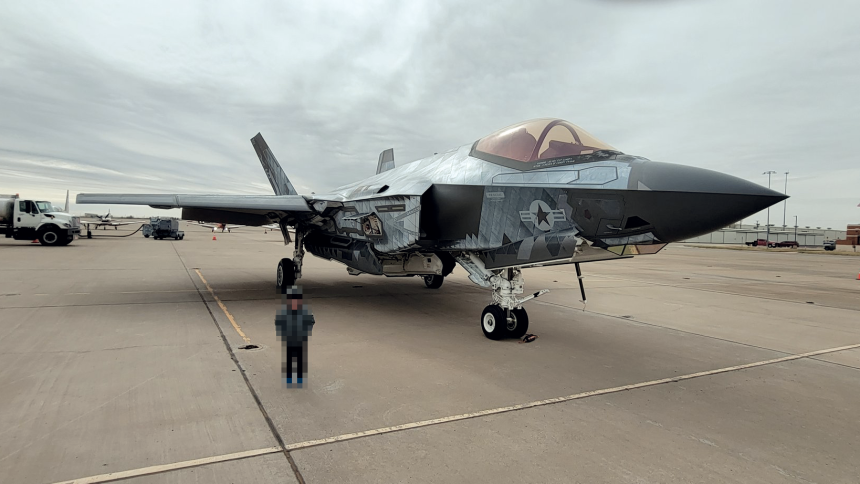The photos, dating back to November 2022, show the second “chrome” F-35C with its peculiar mirror-like coating degraded over time during testing, before the aircraft was returned to its original livery.
Some previously unseen photos recently emerged online, showing one of the U.S. Navy’s F-35Cs which received a peculiar mirror-like coating. The photos, kindly shared with us by @TimHPatriot, were captured at Midland airport, Texas, in November 2022 and show the F-35C BuNo 168842 parked on the ramp.
Notably, the tiles of the coating appear to be heavily degraded or corroded. According to the photographer, the pilot said the coating “were to help with the salty air on the skin, but the tiles kept peeling off in flight.” If the pilot’s explanation was correct, this would be in contrast with one the most likely theory that was shared so far, the reduction of the infrared (IR) signature of the aircraft.
It would make sense for the tiles to peel off in flight if they were not just painted, but applied over the F-35’s paint with an adhesive, similarly to vinyl films which are often used to temporarily apply special markings or liveries to aircraft. As for the salty air, another F-35C with a similar coating was tested aboard the USS Abraham Lincoln (CVN 72) aircraft carrier, while the one in the photo and another one were often spotted in the desert environments of Nellis AFB, Nevada, and Edwards AFB, California.
As we reported at the time, the first aircraft to be spotted with the new coating were F-22 Raptors. The F-22’s delicate radar absorbent material (RAM), which requires extensive maintenance to avoid a quick deterioration, was often seen heavily deteriorated, especially on non-combat coded aircraft used in training.
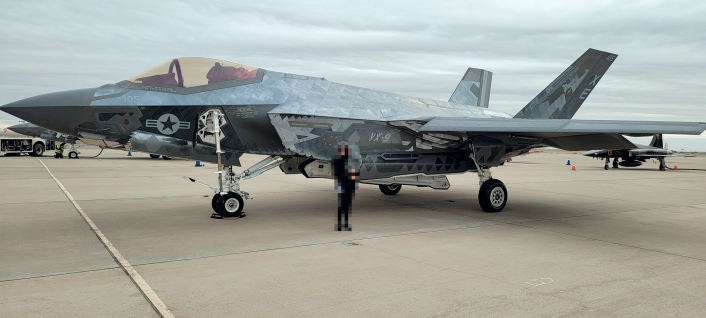
A U.S. Air Force 422nd Test and Evaluation Squadron’s (TES) F-22 Raptor operational test pilot once mentioned in an interview that the coatings were experimental solutions which were being tested to see if they made it easier to maintain the sustainability and reliability of the aircraft.
This could have very well been the same reason behind the F-35C’s new coatings, making more likely the explanation of the pilot of the aircraft in the latest photos. In fact, during the first operational deployments of the F-35C aboard aircraft carriers around the world, it has been noted that the RAM showed significant wear and tear in the demanding maritime environment, with what appeared to be rusty-looking deposit all across the aircraft.
F-35C BuNo 168842
The F-35C in these “new” photos had been already spotted at Edwards Air Force Base, California, in May 2024. In August 2024, newer photographs provided a better look at its peculiar coating while arriving at Naval Base Ventura County (NBVC) Point Mugu, California. The aircraft is assigned to the U.S. Navy’s Air Test and Evaluation Squadron Nine (VX-9) out of Naval Air Weapons Station China Lake.
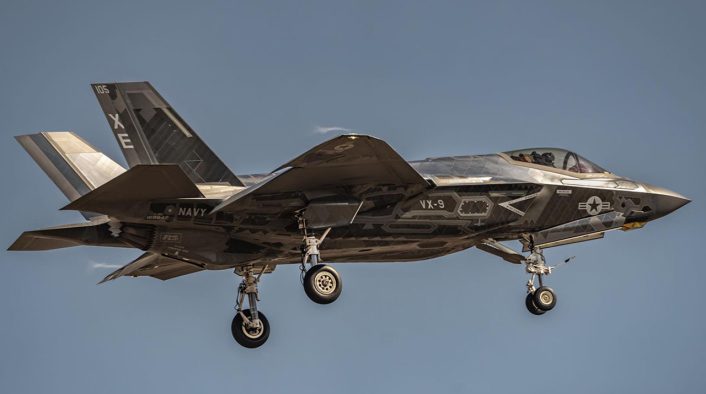
The coating was applied to not interfere with access panels, weapon bays, sensor and antenna areas, landing gear doors and so on. Also, it appears that this coating was applied over the standard grey livery of the F-35C and they appearance changes depending on the angle on observation. The tiles have different dimensions and shapes, with some areas showing larger diamond-shaped tiles, while other area have smaller diamond or triangle-shaped tiles.
The F-35C XE-105 is only the latest of many aircraft to be seen with this new mirror-like coating, following two F-22 Raptor and a F-117 stealth fighters that have been spotted flying since November 2021. The layout of the F-35’s coating is similar to what was seen on the F-22, with what appear to be small, mirror-like tiles that have been extensively applied on the nose section, weapons bay doors, fuselage and also inner and outer face of the twin tails.
As for the F-22, the coating has been applied to not interfere with access panels, weapon bays, sensor and antenna areas, landing gear doors and so on. Also, it appears that this coating has been applied over the standard grey livery of the F-35C and they appearance changes depending on the angle on observation. The tiles have different dimensions and shapes, with some areas showing larger diamond-shaped tiles, while other area have smaller diamond or triangle-shaped tiles.
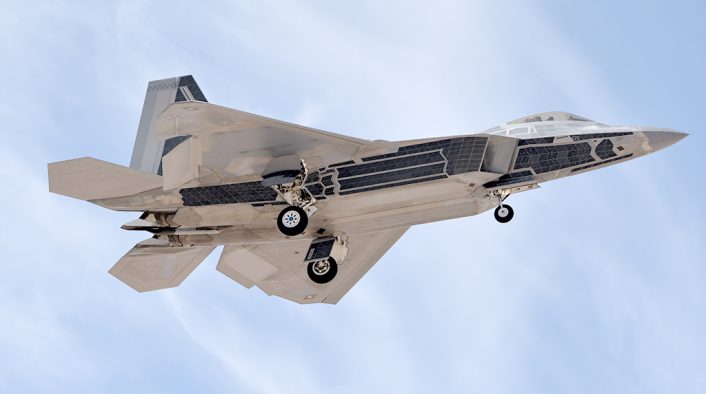
Many theories emerged about the origin of these coatings, but without any official confirmation. The most credited ones were testing activities related to counter-IRST (InfraRed Search & Track) technologies or targeting systems, some kind of radar absorbent material (RAM) replacement or a passive laser defense system.
The photos captured at Midland airport might be the last of the aircraft before it was returned to its standard livery. In fact, the airframe 168842 was spotted in early 2023 with the usual grey livery, without the mirror-like coating. The F-35C later changed also its Modex from XE-105 to XE-101, but remained still assigned to VX-9.
It is unclear, however, which were the results of the testing and if it reached its objectives before the coating was removed.
Testing on the aircraft carrier
Another F-35C with a mirror-like coating, this time assigned to Strike Fighter Squadron (VFA) 125, was was photographed during a touch and go on Nov. 30, 2023, on USS Abraham Lincoln (CVN 72). The aircraft carrier was underway conducting routine operations in the Pacific Ocean, with the “Rough Raiders” of VFA-125, a Fleet Replacement Squadron from NAS Lemoore, California, embarked.
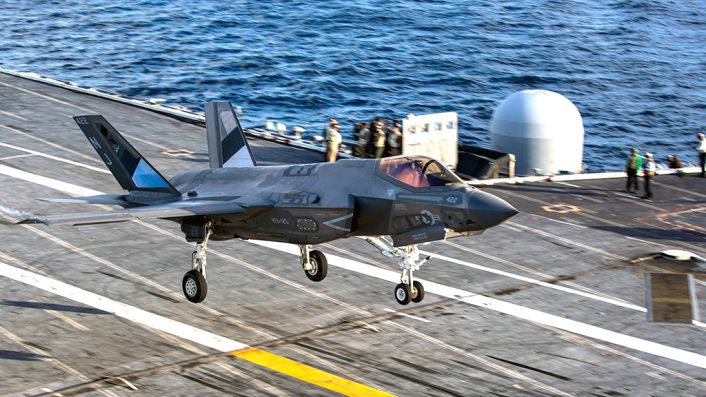
This was the first time, at least to our knowledge, that this exotic scheme of the F-35 was spotted in a carrier environment. This time, however, the coating was not applied extensively as in the other cases, but can be seen only on both sides of the vertical tails and wings, while the fuselage has the standard F-35 coating.
The “chrome” coating alternated dark and shiny patches, making up three larger stripes of different colors. While it was unknown why the new coatings are being used by a FRS on an aircraft carrier, a plausible hypothesis we posited was a test in the harsh maritime environment with aircraft subject to a high volume of flight activity.
Thanks again to @TimHPatriot for allowing us to use his photos!

